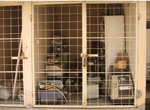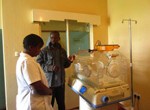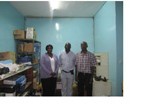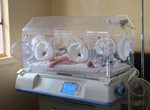 I see a lot of medical equipment that isn’t working. In fact, that’s my job. I’m a biomedical engineer and I spend a lot of time in Africa working with hospital staff, educators, and policy makers trying to understand why equipment doesn’t work and trying to do something about it. The figures themselves speak loudly. There isn’t a large evidence base, but the World Health Organization estimates that 50-80% of medical equipment in developing countries isn’t working. The rough figure from many hospitals I’ve visited in West and Southern Africa is around 40%.
I see a lot of medical equipment that isn’t working. In fact, that’s my job. I’m a biomedical engineer and I spend a lot of time in Africa working with hospital staff, educators, and policy makers trying to understand why equipment doesn’t work and trying to do something about it. The figures themselves speak loudly. There isn’t a large evidence base, but the World Health Organization estimates that 50-80% of medical equipment in developing countries isn’t working. The rough figure from many hospitals I’ve visited in West and Southern Africa is around 40%.
Photo: Unused equipment being stored at a West African hospital.
Ask anyone who has worked in a low resource hospital and they will tell you that the lack of medical equipment that is either available or working is a critical barrier to their ability to deliver health services to patients.
I’ve seen entire maternity wards that rely on a single blood pressure machine and weighing scale: no oxygen, no foetal or maternal monitoring… let alone point of care diagnostics.
Recently, I visited a hospital in central Zambia where a single oxygen concentrator was shared between the operating theatre and all of the clinical wards, moved around by harried nursing staff for the next emergency.
An x-ray machine at a large district hospital in the Gambia was down for almost a year because a critical part needed to be sourced and then fitted into the machine by an engineer from abroad, all at great expense to the hospital whose operating budget didn’t have a lot of “wiggle room.”
So why does this happen and what can be done about it?
One of the biggest problems is training. Clinical staff using the equipment need the right training to operate it comfortably and confidently; maintenance staff need the same in order to be able to service it. Without adequate training, one small fault on an expensive piece of equipment can banish it to the heap forever.
Photo: Nurse being trained to use an infant incubator in Eastern Zambia.
Another problem is resource, both material and financial. It costs money to order consumables and reagents, spare parts, and other maintenance materials. Maintenance staff need to be equipped with tools and test equipment, or else they won’t be able to put any training they’ve had to good use.
I’ve met more bright maintenance technicians than I can count in the Gambia, Senegal, Guinea-Bissau, Ghana, Uganda, and Zambia. But I’ve seen very few maintenance workshops that were well stocked with tools and test equipment or basic spare parts such as fuses and electronic components.
Photo: Biomedical engineering team and workshop at hospital in Zambia: recent training programmes have increased their profile within the hospital.
The physical environment can also be quite harsh. It can be dusty and humid, with temperatures that rise to about 40 degrees Celsius. Poor electrical systems can lead to large voltage fluctuations and outages. Reagents can spoil quickly when a power cut affects a freezer that isn’t on backup power. All of this impacts the medical equipment in a health facility.
Why else is so much equipment unavailable or out of use?—the two big “P’s”: policy and planning. Most hospitals, district and provincial health offices, and ministries of health in the places I work have extremely limited capacity—both human and financial—to proactively plan for their equipment. They end up caught in a vicious cycle of having to react to bad events instead of planning to avoid them.
For example, they need to order an emergency spare part and wait months until it arrives to fix the machine. Or they need to graciously receive whatever equipment is donated to them—whether or not it is useful—instead of engaging donors with details of what they need most urgently.
Another culprit is a symptom of aid and development more broadly. Each large agency donates equipment to support its health priorities: e.g. infant incubators for maternal and child health, viral load counters for HIV/AIDS programmes, and mobile x-ray units for tuberculosis.
Photo: A new incubator that replaced a thirty year old box with a lamp.
These donations are absolutely necessary for hospitals and health systems with such limited resources. But they are not always coordinated effectively and the “vertical introduction” of new equipment can be ineffective.
I recently did an audit of emergency obstetric and neonatal care equipment and sat in meetings with district health officers who asked as a starting point, “Which emergency obstetric care equipment? From donor x, y, or z?”
They had received donations of the same equipment from three different donors in the last two years. So a hospital that now has six infant incubators and twelve foetal monitors may still lack basic diagnostic equipment for its out patient department or eye care clinic.
Another reason why this happens is the limited planning capacity in place at the health facility and health system level. Without inventories of what equipment is available at each of its hospitals and health centres, and what services are offered at each, how can a district health office know what equipment to prioritise with donor funds?
The point is that it’s never about the equipment at the end of the day. It’s about people: the people who plan for the equipment and procure it, those who use it and those who maintain it. They all need adequate training and resources to do so effectively.
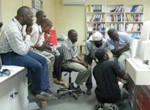 Photo: Training session on lab equipment maintenance in the Gambia.
Photo: Training session on lab equipment maintenance in the Gambia.
I work closely with a biomedical engineer at the Zambian Ministry of Health. He is Zambia’s chief medical equipment officer, the only engineer within the ministry. As such, he is responsible for advising on all things to do with medical equipment at a national level: procurement by the government and by donors, drafting and enacting new policies, and managing maintenance.
Unsurprisingly, his phone doesn’t stop ringing.
That’s why organisations such as Lifebox are so important. Not only do they provide appropriate equipment designed specifically for use in low resource hospitals at a low cost, but they also offer comprehensive training that covers safe anaesthesia and surgery as well as pulse oximetry. It is this combination that is rare and so vital to ensuring equipment is available where and when it is needed in low resource settings. As BMJ readers, I’m sure you can appreciate why this is so important and will consider supporting Lifebox’s fantastic work in the field!
Shauna Mullally is a biomedical engineer who specialises in the management of medical equipment in low income countries.

